How To Use Makeup To Plump Collapsed Nostril
Rhinoplasty Tutorial
(Annotation: All illustrations were created by Dr. Lam for his textbook, Comprehensive Facial Rejuvenation. All before and after photographs are too Dr. Lam's patients.)
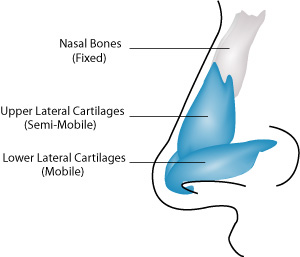
Anatomy
The olfactory organ is perhaps 1 of the most complicated anatomic features of the face up. Patently, this brief tutorial is not intended for the reader to be a chief in nasal anatomy but to understand some of the fundamental anatomic considerations that impact on cosmetic and functional cosmetic nose enhancement
The olfactory organ is basically divided into 3 areas. The upper one third of the nose is made of nasal bones and is rigid and immobile. When at that place is a traumatic injury, the nasal bones are about likely broken and need to be realigned, as shown in the below Figure.
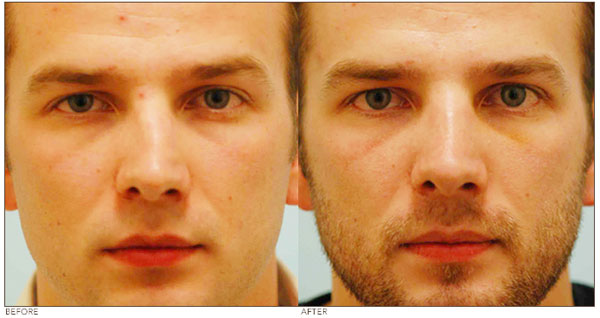
At times during major trauma, the middle tertiary of the nose, which is made of semi-mobile cartilage, called the upper lateral cartilage, can likewise be damaged and must be repaired as in the following photo.
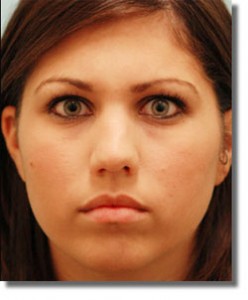

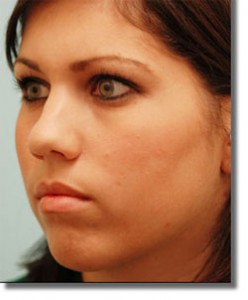
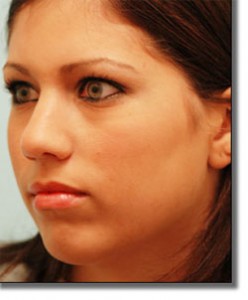
This gentleman appears to have a bony hump but in fact has complete collapse of the center 3rd of his nose from a prior hockey blow which was meticulously rebuilt using septal cartilage from inside his nose. This is known as a saddle nose deformity.
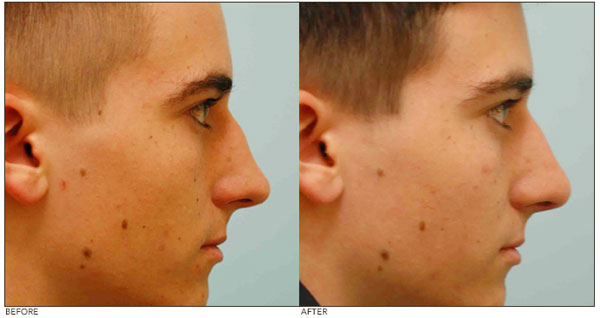
The bottom 3rd of the nose is fabricated of very flexible cartilage, consisting of what is chosen the lower lateral cartilages, that make upward the nasal tip. This example shows an private who has lost almost his entire bottom third of his nose including part of his center 3rd of his nose, which had to be recreated in iii layers: the inner mucosa, the cartilage framework (shown in the beginning illustration) and the outer peel.
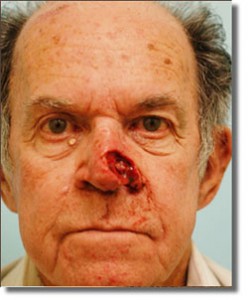
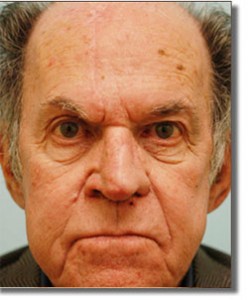


Equally mentioned, the nose is essentially comprised of three layers, the inner mucosal layer, the cartilage and bony framework, and the overlying skin/muscle layer. The first illustration above focuses on the framework of the nose, which is the focus of cosmetic rhinoplasty. However, every bit shown in in a higher place figure, when all three layers are lost, the reconstruction must involve recreating each of the three layers with similar tissue.
Preoperative Evaluation
During a consultation, Dr. Lam is focused on all three layers of your nose to determine the candidacy for you to have a successful rhinoplasty. For a cosmetic result, the outer two layers, the skin and cartilage, are the about of import layers for a meticulous evaluation. For functional rhinoplasty (to be discussed), the inner ii layers are the almost of import, i.e., the framework and the inside of the nose.
The best analogy to empathise how rhinoplasty works is to think of a tent. The outer fabric that hangs over the tent is analogous to the skin. The steel poles of the tent are considered the framework of the olfactory organ, i.e., the cartilage and nasal basic. Dr. Lam's surgery involves working primarily on the framework of the nose (equally mentioned, see Figure 1). Therefore, stronger steel poles of the tent (the cartilage and bone) permit a improve, more defined aesthetic event. Thicker tent fabric that overlies the steel poles (that would be the pare) can limit what would exist seen later cosmetic rhinoplasty. That is why Dr. Lam carefully evaluates your skin thickness and cartilage recoil during a consultation to make up one's mind 1) if y'all are candidate for rhinoplasty and 2) which method would be appropriate for y'all given your specific type of anatomy. For example, the thicker skinned Asian or African-American nose is usually (but not e'er) a candidate for traditional Occidental fashion rhinoplasty, and a different method must be used for a successful consequence.
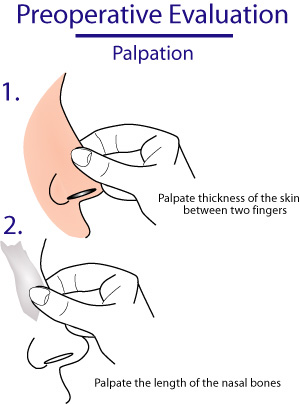

Nasal and Facial Aesthetics
 Over the years, there accept been many aesthetic rules that have been devised to assistance guide plastic surgeons in determining what is considered beautiful and attractive. Although Dr. Lam has studied all of these rules, his emphasis during surgery is to perform rhinoplasty that is highly-seasoned to his creative center that will match your expectations established during consultation with him. Dr. Lam has included some basic rules on proportion and facial/nasal metrics herein for your pedagogy.
Over the years, there accept been many aesthetic rules that have been devised to assistance guide plastic surgeons in determining what is considered beautiful and attractive. Although Dr. Lam has studied all of these rules, his emphasis during surgery is to perform rhinoplasty that is highly-seasoned to his creative center that will match your expectations established during consultation with him. Dr. Lam has included some basic rules on proportion and facial/nasal metrics herein for your pedagogy.
The olfactory organ should fit pleasantly on the face up in terms of size and proportion both vertically and horizontally. A vertical dominion of thirds suggests dividing the face into thirds from the lesser of the mentum to the bottom of the nose, from the lesser of the nose to the superlative of the nose, and from the top of the nose to the starting time of the hairline. Apparently, this dominion of thirds only serves as a basic guideline for understanding what would be ideal for a rhinoplasty patient. The rule of fifths is used to establish the platonic width of the nasal tip, which should exist roughly equal to the width of the eye and the altitude from the outer office of the eye to the outer part of the ear.
The ideal male nose and the ideal female nose are quite different. Dr. Lam is always careful to evaluate the nose in terms of overall facial shape but besides in terms of the person'southward gender. An ideal female nasal tip has a slight overall rotation upward but is much less upturned than compared with the platonic aesthetic from the 1980s for women. Today, the caste of rotation is more than conservative. The nasal bridge height on a male person can likewise exist much college and stronger than a female person merely in any case, the female nose should e'er maintain a directly not scooped profile.
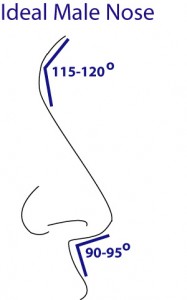
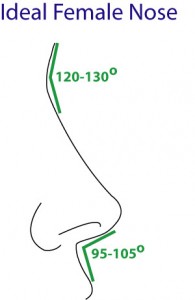
The male nose below is shown with a reduction in the hump but maintenance of the overall strength and dimension that is required for masculinity.

The female person nose below is more than feminized by reducing a large profile hump and at the same tip rotating the tip upward a bit and refining the tip size to create a more feminine appearance.
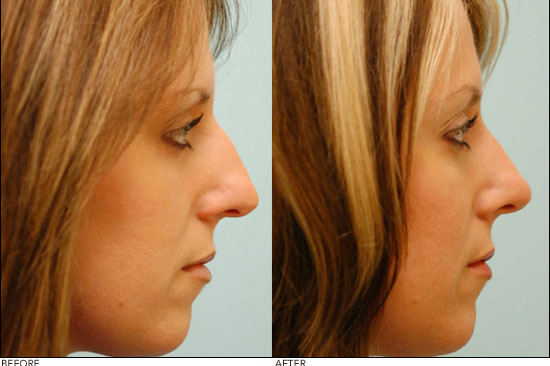
The following illustrations provide basic rules that assistance establish what may be considered aesthetically pleasing in a Caucasian rhinoplasty. Unfortunately, there are no artful rules that define non-Caucasian rhinoplasty and a give-and-take with Dr. Lam will help establish what shape and contour of your olfactory organ would best fit your aesthetic ideals in terms of preserving or softening your indigenous features.

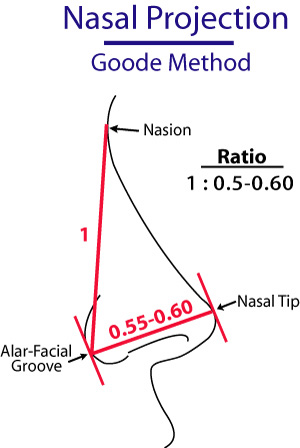
As you tin run across in these two ethnic rhinoplasty examples, Dr. Lam has preserved the patient's identity but created a more harmonious and aesthetically pleasing result. In the Vietnamese women, he gently raised the bridge without modifying the nasal tip and at present the nasal tip appears to be smaller and more in proportion.
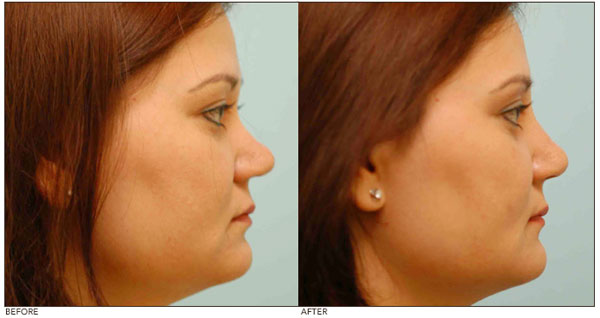
This African-American adult female also exhibits a smaller bridge, which makes her tip await bigger. Dr. Lam reduced and refined her nasal tip at the same time as raising the nasal bridge. Now the bridge and tip are more harmoniously in residuum and aesthetically pleasing.
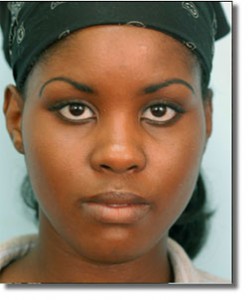
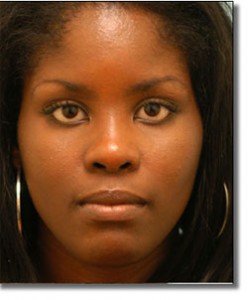
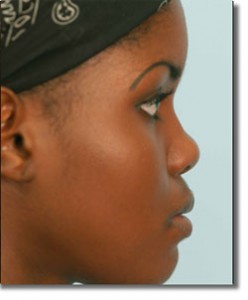
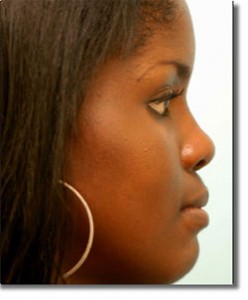
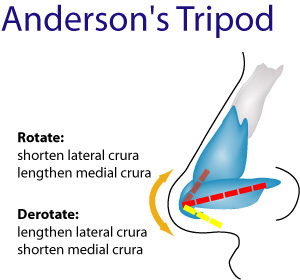
Anderson's Tripod: Nasal Tip Dynamics
The nasal tip is 1 of the most complicated anatomic areas to understand fully. The tip position and shape are the 2 important attributes when evaluating the nasal tip. Jack Anderson'southward tripod metaphor for the nasal tip is the best
This woman underwent nasal tip refinement and slight rotation of the nose using a bourgeois trimming of her lower lateral cartilage and what is known equally a dome-binding suture to drag the nasal tip. The dome-binding suture works to create a narrower tip and likewise to rotate the tip upward. In narrowing the tip, the outer legs of the tripod are shortened and the center leg is lengthened and then the nasal tip rotates up.
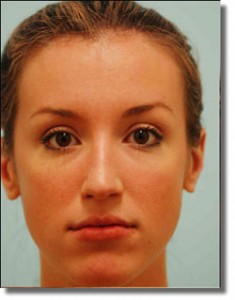
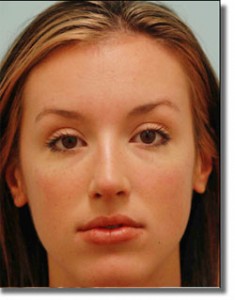


For a nose that is completely collapsed or markedly rotated downward like for the gentlemen pictured below, the outer legs of the tripod must be physically shortened using a technique known as a lateral crural overlay. This technique facilitated sufficient rotation of the tip up to a more rejuvenated position and also permitted him to breathe much better.

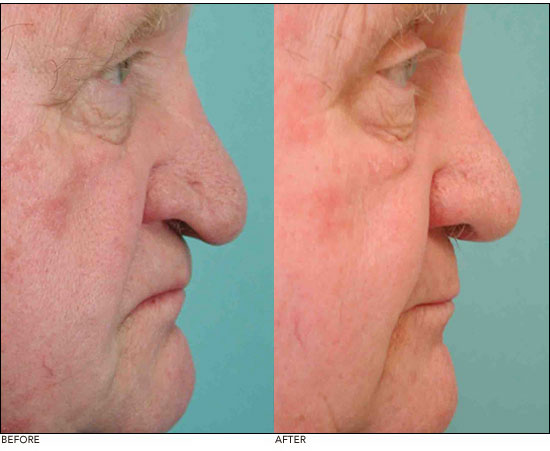
This woman had an aggressive prior rhinoplasty which involved over-reduction of the nasal bridge, a twisted nasal tip, and over rotation and over project (too long) of the nasal tip. She as well could not exhale. Besides restoring her nasal passage by stenting the external valve (run into below nether Functional Considerations for more information), Dr. Lam performed a medial crural overlay in which the middle tripod leg was shortened in order to reduce the degree of rotation and projection of the nose. He also restored the tiptop to the nasal bridge.
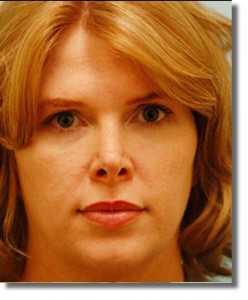
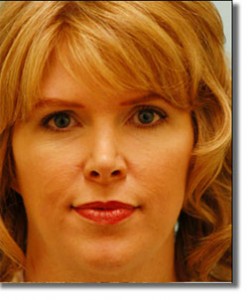
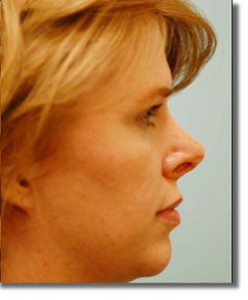
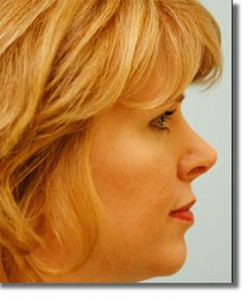
 Functional Considerations
Functional Considerations
The nose is a respiratory organ, and the nasal airway must be preserved if not enhanced during rhinoplasty. As well the septum (the segmentation that divides the nose), at that place are two other principal regulators of nasal airflow: the external nasal valve and the internal nasal valve. The external nasal valve essentially consists of the structures that brand up the nostril of the nose.
External valve collapse can occur due to many causes. The gentleman pictured below has a condition known every bit rhinophyma. The exuberant overgrowth of his nose tissue has led to external valve plummet due to the weight of the tissue. Reduction of the overgrown tissue not but provided aesthetic improvement just also permitted him to exhale once more.
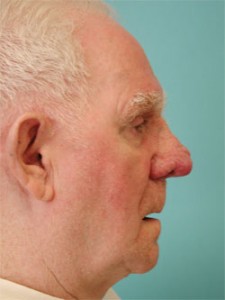

At times, a olfactory organ that is over-reduced from prior rhinoplasty may have complete plummet. In this situation, alar-batten grafts can be used to strengthen, reinforce, and rebuild the integrity of the external valve like the flight buttresses in Romanesque compages.
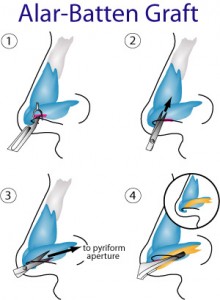
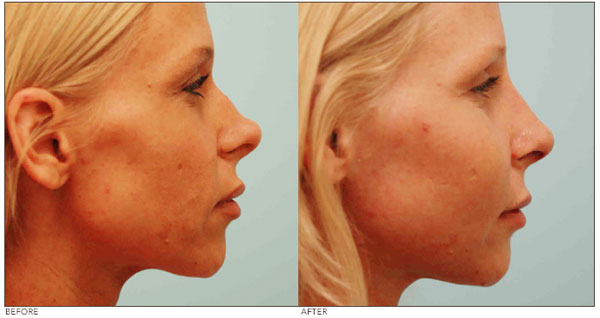
The internal nasal valve is the master regulator of nasal airflow and can exist compromised due to injury, prior rhinoplasty, or other causes. The internal valve is defined by the bending that the septum makes with the upper lateral cartilage.
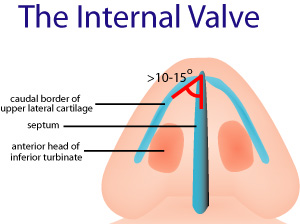
In lodge to restore patency to the internal valve, the primary method is to open up the bending with what is known every bit a spreader graft. The ideal spreader graft is derived from a graft borrowed from the septum.
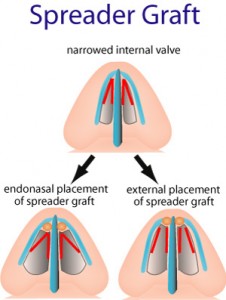
This woman is shown after a prior blow with non simply broken nasal bones but also a collapsed internal valve. The internal nasal valve was reconstructed on the right side using septal cartilage as a spreader graft along with other rhinoplasty refinements for artful reasons.
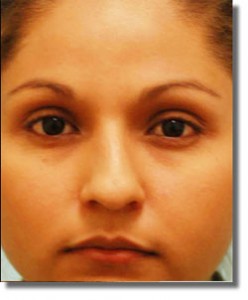
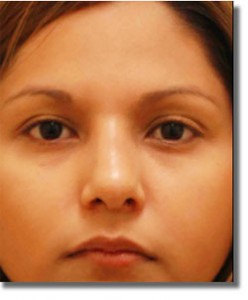
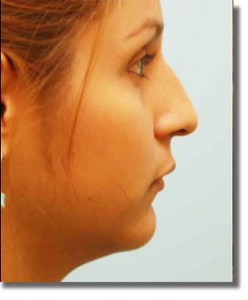
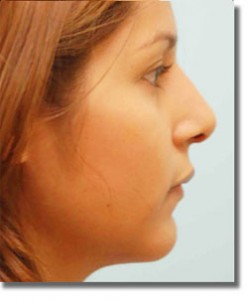
How To Use Makeup To Plump Collapsed Nostril,
Source: https://www.lamfacialplastics.com/dallas-plastic-surgery-learning-modules/rhinoplasty-tutorial/
Posted by: singletonbectinced.blogspot.com


0 Response to "How To Use Makeup To Plump Collapsed Nostril"
Post a Comment